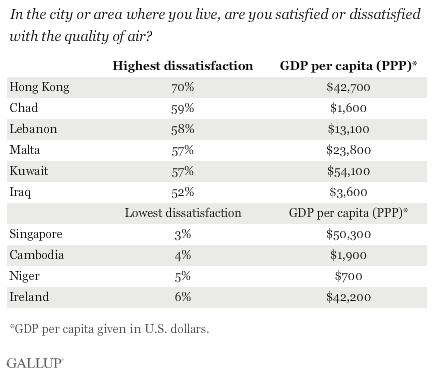WASHINGTON, D.C. -- As the world marks Earth Day's 40th anniversary Thursday, Gallup surveys in 153 countries highlight a major environmental problem that affects people in developed and developing nations -- air quality. One-quarter of the world's adults -- or roughly 1.1 billion people -- are critical of the air quality in their communities; dissatisfaction is highest in the Middle East and North Africa and lowest in Asia.

Unlike global assessments of water quality, the geography of dissatisfaction with air quality does not have as clear economic boundaries. This is evident in the list of countries with the highest and lowest dissatisfaction. At least half of adults surveyed are critical of the air quality in Hong Kong (70%), Chad (59%), Lebanon (58%), Malta (57%), Kuwait (57%), and Iraq (52%). At the other end of the spectrum, dissatisfaction with air quality is lowest in Singapore (3%), Cambodia (4%), Niger (5%), and Ireland (6%).

The World Health Organization (WHO) estimates that about 2 million premature deaths a year can be attributed to the effects of air pollution. Although Gallup's data show poor air quality is perceived as a burden in developed and developing countries, WHO maintains that people in developing countries shoulder more than half of the health burden from air pollution. Those in developed countries are often better equipped to deal with the consequences, but that still does not mitigate the underlying health risks. Since the first Earth Day, international organizations and many countries have instituted measures to reduce pollution, but air quality clearly remains a disconcerting issue to many.
See all country-level results below.
For complete methodology and specific survey dates, please review Gallup's Country Data Set details.
Survey Methods
Results are based on telephone and face-to-face interviews with approximately 1,000 adults in most countries, aged 15 and older, conducted in 2006, 2007, 2008, 2009, and 2010, in 153 countries and areas. For results based on the total sample of national adults, one can say with 95% confidence that the maximum margin of sampling error ranged from a low of ±2.1 percentage points in China to a high of ±5.7 percentage points in Slovenia. The margin of error reflects the influence of data weighting. In addition to sampling error, question wording and practical difficulties in conducting surveys can introduce error or bias into the findings of public opinion polls.

